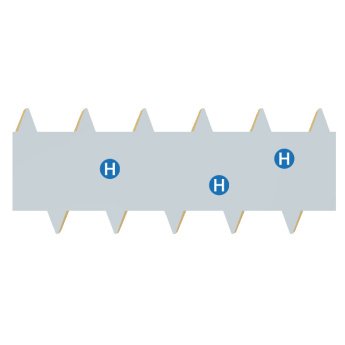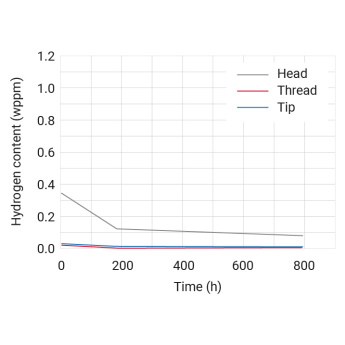Hydrogen embrittlement
Research project: SCREW_HISCC

Internal hydrogen embrittlement (IHE)
Internal Hydrogen Embrittlement (IHE) is generated during the production of fasteners, particularly during forming, hardening and electrolytic coating. Hydrogen can penetrate the material and lead to brittle fracture under load. The risk is influenced by various factors, including the raw material, as well as activators and inhibitors in the pickling and coating processes and heat treatment. Controlled production processes and suitable materials are crucial to avoid IHE.
Process verification
As part of the FFG Bridge Project “SCREW_HISCC,” the screw production process at Schmid Schrauben HainfeldGmbH was evaluated for IHE compliance. The project was conducted at Graz University of Technology by the Institutes of Timber Engineering and Wood Technology, as well as the Institute of Material Science, Joining, and Forming (IMAT), with support from industrial partners Schmid Schrauben Hainfeld GmbH and Stiefler GmbH.
During the study, screws were sampled from the ongoing manufacturing process at key production stages,
such as quenching and galvanizing. Their hydrogen content was measured using a thermal conductivity
detector (TCD). The initial measurements were taken immediately after removal from production and repeated over time while the screws were stored in a dry atmosphere-standard practice during manufacturing.
The results, illustrated in the diagrams, clearly show that hydrogen diffuses out almost entirely during the resting phase. These findings align with our extensive industry experience, confirming the reliability of our process in mitigating hydrogen embrittlement risks.
After hardening
The screw on the left-hand side of the diagram represents the hydrogen (H) content directly after hardening. As can be seen in the diagram, the hydrogen (H) content is very high at this time (time = 0 h).The diagram shows the development of the hydrogen (H) content over time. The different lines symbolize the different parts of the screw.
The screw on the right-hand side of the diagram shows the hydrogen (H) content at the last test (time = 800 h). With sufficient resting time, the hydrogen (H) diffuses out of the screw on its own.
After galvanizing
The screw on the left-hand side of the diagram represents the hydrogen (H) content directly after electroplating process. As can be seen in the diagram, the hydrogen (H) content is high at this time (time = 0 h).The diagram shows the development of the hydrogen (H) content over time. The different lines symbolize the different parts of the screw. After a short time in a normal atmosphere, the hydrogen (H) diffuses out again by itself. Baking would have the same effect
The screw on the right-hand side of the diagram shows the hydrogen (H) content at the last test (time = 800 h).
Conclusion
Schmid RAPID® screws are stored under controlled conditions that prevent internal hydrogen embrittlement (IHE). Proper storage ensures that any hydrogen introduced during manufacturing naturally diffuses out, eliminating the risk of IHE in the finished screws.Environmental hydrogen embrittlement (EHE)
Environmental Hydrogen Embrittlement (EHE) occurs when hydrogen penetrates the material during use and causes damage. The risk is particularly high if the screw is exposed to high tensile loads. Hydrogen can originate from the environment, e.g. from corrosive media or cathodic protection. Embrittlement leads to gradual cracking and can lead to sudden failure of the screw. A suitable choice of material and corrosion protection measures help to minimize the risk of EHE

H in the steel microstructure
The left image displays a sectional view of a fracture caused by hydrogen embrittlement. Hydrogen accumulates at the grain boundaries, weakening the microstructure.What happens in case of corrosion?
Exposure to moisture and/or acidic woods accelerates screw corrosion. Initially, the galvanic protective layer deteriorates, followed by corrosion of the base material, leading to the formation of red rust. This process releases hydrogen (H), which enters the screw through microcracks. The hydrogen then diffuses into the screw, migrating to the point of highest stress. Over time, the crack propagates until the screw’s cross-section becomes too weak to support the applied load, ultimately causing failure. This can occur at approximately 30 % of the screw’s characteristic tensile capacity (ftens,k).

Field test
The SCREW_HISCC project also explored the behavior of RAPID® screws in wood under humid conditions, specifically examining when corrosion-induced hydrogen embrittlement might cause failure. To test this, screws were embedded in various wood species (Beech, Larch, Douglas Fir, Oak, and Birch), sealed in a service class 2 environment according to EN 1995-1-1, and subjected to constant axial stress. Even after nearly two years under these conditions, none of the screws have failed.Conclusion
After nearly two years of testing, none of the Schmid RAPID® screws failed due to corrosion-induced hydrogen embrittlement.This confirms that with proper storage in dry environments and avoiding corrosion, the risk of Environmental Hydrogen Embrittlement (EHE) is very limited, ensuring long-term durability and structural integrity.







